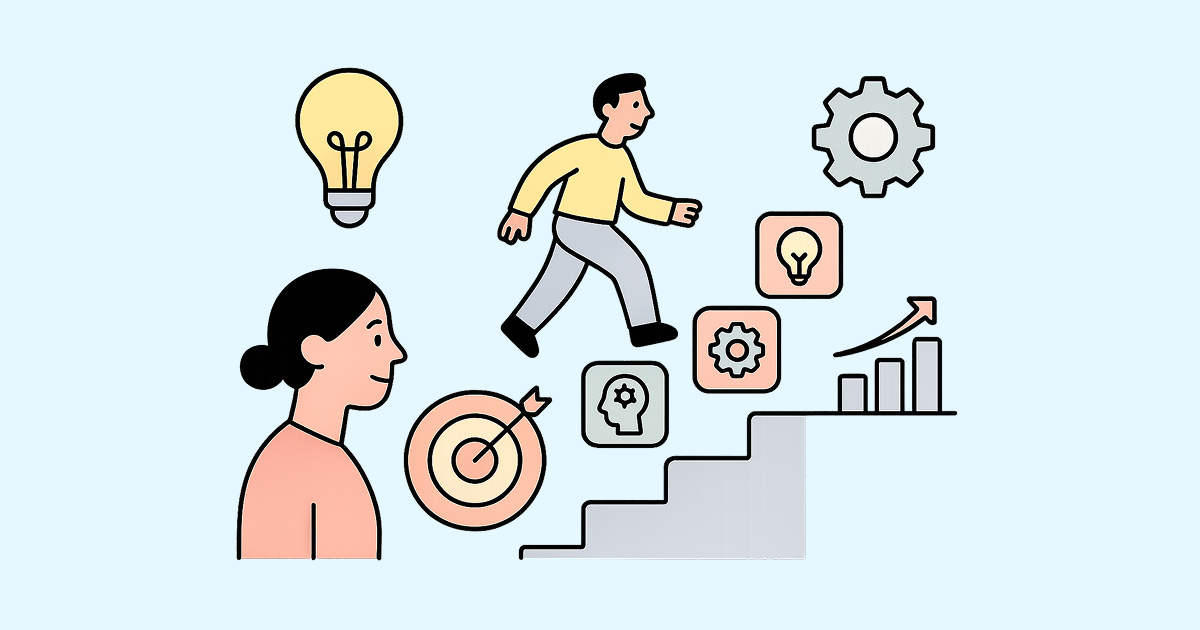A learning ecosystems how-to: Framework and steps to take

Learning ecosystems have replaced traditional L&D over the past five years.
This holistic model is more than a platform; it’s a collaborative environment that helps organisations adapt and grow. But what exactly is it, and how do you develop one?
That’s what Bas Puts, Global Head of Learning and Skill Architecture at Siemens, joined GoodHabitz’s Moving Forward podcast to discuss. Based on that interview, this article will:
- Define corporate learning ecosystems
- Lay out a workable framework and practical steps
- Explore a real-world learning ecosystem example
What is a learning ecosystem?
Rather than a conventional L&D system that funnels knowledge from a single department to a single employee, a learning ecosystem engages all relevant stakeholders to share information.
Rather than a single person or department being the single source of knowledge and channel to individual employees, the ecosystem facilitates sharing knowledge across the organisation.
At its core, a learning ecosystem brings together technology, content, and people to create a seamless learning experience. The platforms are user-centred to maximise engagement.
Why invest in a learning ecosystem?
This shared learning experience doesn’t just empower employees to expand their skillsets. It also engages them not just in the learning process but with each other, which is important for employee retention.
McKinsey & Company found that a strong culture makes organisations 25% more likely to retain employees for five or more years. That type of retention is crucial at a time when 29 European countries are experiencing a talent shortage.
Key ingredients in a successful learning ecosystem
Four factors make a corporate learning ecosystem really shine:
- Technology: the platform needs to be user-friendly and supremely intuitive. As Bas described on our podcast, a team member should always be no more than two clicks from relevant information.
- Content: there should be both user-generated and curated content. It should be engaging and inspirational, encouraging users to learn more!
- Collaboration: community, a key differentiator between ecosystems and modules, requires L&D to actively facilitate people working together whilst curating quality content.
- Feedback: there’s a reason why apps with statistics dominate their competitors. Measurement mechanisms provide valuable user feedback and encourage continued engagement. After all, there’s a reason why a certain green owl dominates all the other language apps.
Learning ecosystem example: Siemens’ collaborative approach
Siemens’ new approach started with the realisation that the function of L&D has evolved. Bas explained in the Moving Forward episode:
“We used to say that the L&D department was like a game of soccer - we were in the Champions League, and we knew exactly what it took to be successful. But now, all of a sudden, we’re playing basketball. The requirements for L&D are completely different, and what success looks like has fundamentally changed.”
They began by working with specialists to plan their learning ecosystem and build it as a long-term campaign, rather than ad-hoc content sharing.
This initial campaign included user interviews that revealed a crucial fact: employees don’t always know they can take time to learn. Part of creating an ecosystem is encouraging team members to explore what interests them.
Their next move was to share content creation outside of L&D. Bas revealed a surprising inspiration:
“Think about TikTok - people follow people. Learning ecosystems work in the same way - treat it as a co-creation activity. Everyone can become a curator - there are 1700+ of them at Siemens.”
Once they had developed a robust system, it was time to set goals. They made sure these targets were integrated into everyday business.
Bas pointed out:
“At Siemens, Learning Hours (the amount of time spent on the learning ecosystem) is one of the overall targets of the company. These metrics trigger the discussion between the manager and the employee, in terms of how the learning hours spent will also be meaningful. This then can feed back into the dialogue around the conversation relating to career development.”
Five steps to build a learning ecosystem
1. Define organisational needs and identify stakeholders.
This is highly specific to your business. What are your goals? What skills are you missing to reach those goals? Or do you just want to keep employees happy and engaged?
Next, think about people. Who will be key to a successful implementation? Be sure to think of not just managers but cultural leaders. For example, in a department with a new boss and a long-standing and well-liked project manager, it would be important to get both onside.
2. Foster a culture of collaboration and co-creation.
Culture can be tricky to change, which is why it’s so important to identify stakeholders. Use them to help foster a spirit of collaboration and co-creation. Reward positive actions with appreciation and encourage sharing. The goal is to ‘go from ego to eco’, to use Bas’ words.
3. Select and integrate the right technology.
Look for platforms that are collaborative and intuitive. You want to encourage people across your organisation to share. At the same time, you want to make it easy for users to find the subject that suits them and the information they need.
4. Actively engage your learner community.
Open conversations are a big part of community-building. You need to hear what’s working and what isn’t. You’ll also need to make sure employees know they have the time and space to explore new learning at work.
5. Measure, adapt, and iterate continuously.
Measurement isn’t just a key to user engagement, but it’s also key to iteration. Today’s innovation is tomorrow's relic, so you’ll want to continue to iterate your platform and adapt your culture to stay forward-looking – and learning!
Overcoming common barriers to learning ecosystem success
Just as with any change, there are a couple of hurdles that are common to this type of transition. Here’s how to handle them:
Employee buy-in
In addition to getting key stakeholders on board, make sure your learning ecosystem is tied into the company’s overall strategy. As Bas notes, “There’s a clear acceptance that upskilling and reskilling have to be done faster than ever before.”
Content overload
As the BBC noted, we’re exposed to more information in a day than a 15th-century person learned in their entire life.
Small wonder that employees might have content overload. That’s why the platform must be intuitive, and the content must be approachable. Learning must be fun.
Engagement fatigue
Likewise, employees have many channels calling for their attention in their work and home lives. Your corporate learning ecosystem can’t be yet another channel. It needs to be thoroughly integrated into your business culture and goals.
Conclusion: unlock organisational potential with learning ecosystems
Use collaboration and co-creation to create content that engages employees on a user-friendly platform. In addition to upskilling employees for a rapidly changing landscape, it can help retain a strong team.
Curious about how?
Learn more about Siemens’ transition by listening to our podcast episode.



